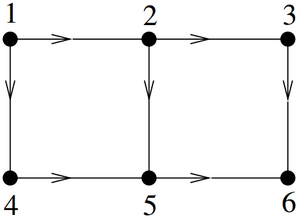Science:Math Exam Resources/Courses/MATH307/April 2013/Question Section 201 06 (d)
{{#incat:MER QGQ flag|{{#incat:MER QGH flag|{{#incat:MER QGS flag|}}}}}}
• Q1 (a) • Q1 (b) • Q1 (c) • Q1 (d) • Q2 (a) • Q2 (b) • Q2 (c) • Q2 (d) • Q2 (e) • Q2 (f) • Q3 (a) • Q3 (b) • Q3 (c) • Q4 (a) • Q4 (b) • QS201 5(a) • QS201 5(b) • QS201 5(c) • QS201 6(a) • QS201 6(b) • QS201 6(c) • QS201 6(d) • QS201 7(a) • QS201 7(b) • QS201 7(c) • QS202 5(a) • QS202 5(b) • QS202 5(c) • QS202 5(d) • QS202 6(a) • QS202 6(b) • QS202 7(a) • QS202 7(b) • QS202 7(c) • QS202 7(d) • QS202 7(e) •
Question Section 201 06 (d) |
|---|
|
Consider the same graph as in the previous question, now interpreted as an internet where the vertices represent web pages and the arrows represent links. (d) Write down the MATLAB/Octave code that would compute the ranking for each page using the eig command. |
|
Make sure you understand the problem fully: What is the question asking you to do? Are there specific conditions or constraints that you should take note of? How will you know if your answer is correct from your work only? Can you rephrase the question in your own words in a way that makes sense to you? |
|
If you are stuck, check the hint below. Consider it for a while. Does it give you a new idea on how to approach the problem? If so, try it! |
Hint |
|---|
|
Science:Math Exam Resources/Courses/MATH307/April 2013/Question Section 201 06 (d)/Hint 1 |
|
Checking a solution serves two purposes: helping you if, after having used the hint, you still are stuck on the problem; or if you have solved the problem and would like to check your work.
|
Solution |
|---|
|
>> [V D] = eig(S) Where V is the matrix of normalized eigenvectors, and D is the diagonal matrix of eigenvalues. It can be assumed that is the first entry in D, the corresponding eigenvector is the first column of matrix V. To get the ranking we scale so that the sum is equal to 1. >> V(:,1) / sum(V(:,1)) |
{{#incat:MER CT flag||
}}


